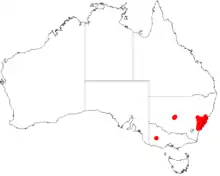Acacia bynoeana
Acacia bynoeana, known colloquially as Bynoe's wattle or tiny wattle, is a species of Acacia native to eastern Australia.[4] It is listed as endangered in New South Wales and as vulnerable according to the Environment Protection and Biodiversity Conservation Act 1999.[5]
| Tiny wattle | |
|---|---|
.jpg.webp) | |
| Scientific classification | |
| Kingdom: | Plantae |
| Clade: | Tracheophytes |
| Clade: | Angiosperms |
| Clade: | Eudicots |
| Clade: | Rosids |
| Order: | Fabales |
| Family: | Fabaceae |
| Clade: | Mimosoideae |
| Genus: | Acacia |
| Species: | A. bynoeana |
| Binomial name | |
| Acacia bynoeana | |
 | |
| Occurrence data from AVH | |
| Synonyms | |
|
Acacia pumila Maiden & R.T.Baker Racosperma bynoeanum (Benth.) Leslie Pedley | |
Description
The small shrub grows to a height of around 0.5 m (1 ft 8 in) and has a decumbent habit. The terete and hairy branchlets have subulate stipules with a length of around 1.5 mm (0.059 in). Like most Acacias it has phyllodes rather than true leaves. The narrowly elliptic to linear shaped phyllodes are straight to slightly curved. They have a length of 1 to 6 cm (0.39 to 2.36 in) and a width of 1 to 3 mm (0.039 to 0.118 in) and are hairy when young but become glabrous with age. The shrub usually blooms in the summertime between December and March producing simple inflorescences that occur singly in the axils with spherical flower-heads that have a diameter of 3 to 4 mm (0.12 to 0.16 in) containing 10 to 25 bright golden flowers. After flowering firmly, papery and brittle seed pods will form that are straight, and raised over the seeds inside. The pods are 1 to 3 cm (0.39 to 1.18 in) in length and 3 to 4 mm (0.12 to 0.16 in) wide.[4]
Taxonomy
The plant was first formally described by the botanist George Bentham in 1855 as part of the work Plantae Muellerianae: Mimoseae as published in Linnaea: ein Journal für die Botanik in ihrem ganzen Umfange, oder Beiträge zur Pflanzenkunde. It was reclassified as Racosperma bynoeanum by Leslie Pedley in 2003 then transferred back to genus Acacia in 2006. The only other synonym is Acacia pumila.[6]
The specific epithet honours Benjamin Bynoe, the Royal Navy surgeon aboard the Beagle who collected the type specimen.[4]
Distribution
The shrub is found in New South Wales mostly from around the Morisett area in the north down to Berrima and the Illawarra region and out to the west as far as the Blue Mountains with another population found in the Hunter Valley and Morton National Park. It grows well in sandy soils as a part of heathland and dry sclerophyll forest communities.[4]
See also
References
- Acacia bynoeana, Species Profile and Threats Database, Department of the Environment and Heritage, Australia.. Retrieved 16 November 2018.
- "Acacia bynoeana". Australian Plant Name Index (APNI), IBIS database. Centre for Plant Biodiversity Research, Australian Government. Retrieved 29 July 2019.
- Bentham, G. (1855) Plantae Muellerianae: Mimoseae. Linnaea: ein Journal für die Botanik in ihrem ganzen Umfange, oder Beiträge zur Pflanzenkunde 26(5): 614
- Harden GJ (1990). "Acacia bynoeana Benth". Plantnet - New South Wales Flora Online. Royal Botanic Gardens, Sydney. Retrieved 17 July 2014.
- "Bynoe's Wattle - profile". New South Wales Office of Environment and Heritage. 1 December 2017. Retrieved 24 August 2019.
- "Acacia bynoeana Benth". Atlas of Living Australia. Global Biodiversity Information Facility. Retrieved 24 August 2019.
